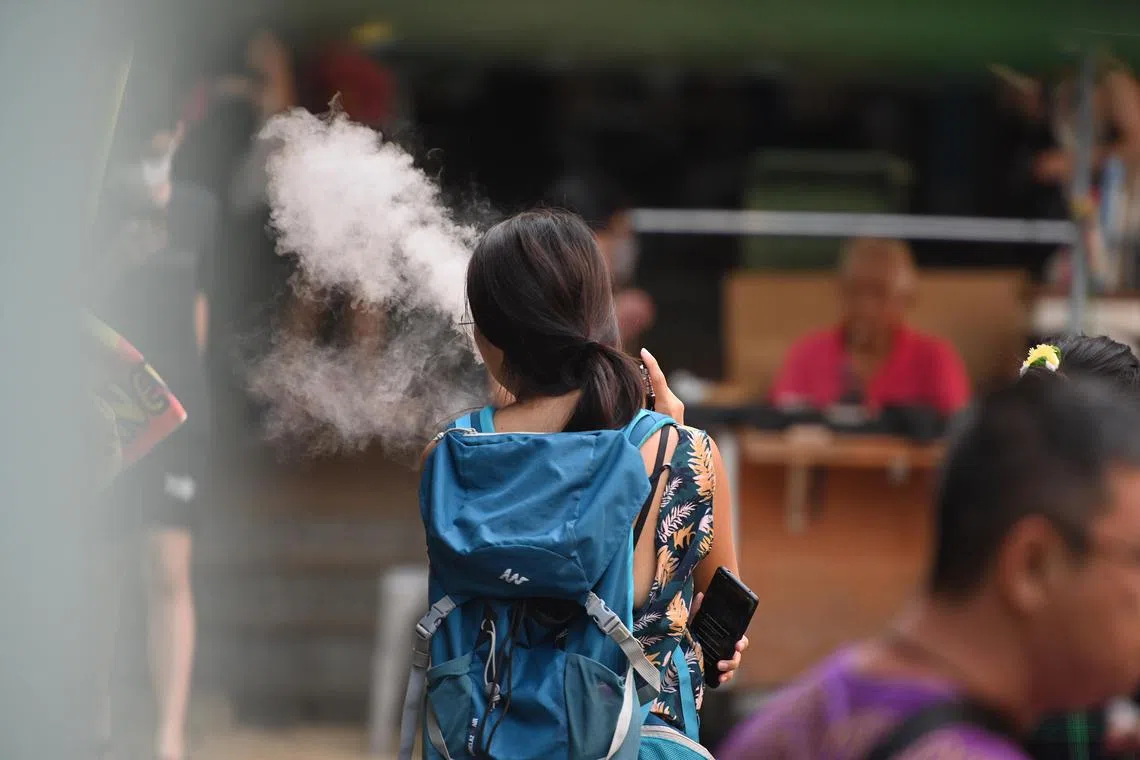askST: What are the dangers of vaping?
Sign up now: Get ST's newsletters delivered to your inbox

Although the authorities have been clamping down on e-cigarettes, figures show that the use of vapes is on the rise in Singapore.
PHOTO: ST FILE
Follow topic:
SINGAPORE - Vaping is illegal in Singapore, with the possession, use and purchase of electronic vaporisers, or vapes, and their related products banned in Singapore since February 2018.
The authorities have been clamping down on these electronic cigarettes (e-cigarettes), targeting both importers and resellers, as well as users.
But latest figures from the Health Sciences Authority (HSA) indicate that the use of vapes is on the rise here,
The Straits Times looks at the dangers of vaping, the penalties when caught, and the latest actions by the authorities.
Q: What is vaping?
A: A vape is an electronic device that works by heating up a liquid to turn it into a vapour that is then inhaled. It is also referred to as an e-cigarette, e-vaporiser or electronic nicotine delivery system.
The liquid is referred to as an e-liquid or juice.
Vapes usually consist of a cartridge that holds the e-liquid, a heating coil also known as an atomiser, sensors that detect when the user inhales and turns the device on, and a battery.
Vape cartridges are sometimes replaceable, and are also referred to as pods.
Q: What chemicals are commonly found in vapes?
A: The e-liquid in vapes usually contains nicotine, flavouring and vitamin E acetate. Nicotine is an addictive substance and is also found in traditional cigarettes.
The flavouring, which is not vetted by the health authorities here, can sometimes release cancer-causing agents such as formaldehyde and benzene when heated.
Vitamin E, in and of itself, is not harmful. But vitamin E acetate, which is used as an additive in e-liquids, can cling to lung tissue when inhaled. Its full effect is still being studied.
Heavy metal particles such as tin, lead and nickel have been found in vapes, and are believed to be a result of the heating mechanism. When inhaled, these can cause respiratory diseases, according to the HealthHub website.
Some vape liquids also contain tetrahydrocannabinol (THC) and cannabidiol (CBD), which are derived from the cannabis plant.
THC is the main psychoactive substance in cannabis that causes users to feel “high”, and is listed as a Class A controlled drug in Singapore. CBD is a core chemical compound found in the cannabis plant. It does not cause the same “high” as THC, and can be found in a limited number of pharmaceutical products.
Q: Why are vapes still in use in Singapore?
A: A disposable vaporiser costs about $30 and can last for roughly 5,000 puffs. Non-disposable vaporisers may cost about $60, and a set of three pods – each lasting for about 500 puffs – costs $17.
In comparison, a packet of 20 premium cigarettes costs about $14.
Vape products are being sold via social messaging platforms like Telegram.
Q: How does vaping affect children and youth?
A: Nicotine is harmful to developing brains, but even without nicotine, inhaling the mist can damage your lungs, said lung surgeon Aneez Ahmed.
He explained that vaping mist contains particulate matter, which can trigger inflammation and cause blood vessels in the lungs to close up.
Dr Aneez previously operated on two vapers, aged 19 and 21, who suffered from pneumothorax, or collapsed lungs. He said vaping delayed their recovery.
Medical experts have also warned that the cancerous effects of inhaling the other chemicals
The Ministry of Education said that over the past three years, an average of about seven out of every 1,000 students from primary schools, secondary schools and pre-university institutions were caught for smoking and vaping offences. But vaping appears to be popular with young people, with reports of even primary school pupils getting caught.
In January, a man was nabbed by HSA for selling vapes to students at West Mall.
Q: What are the signs that a person is vaping?
A: According to medical research centre and network Nebraska Medicine, these are seven signs to look out for:
A sweet scent in the air
Unfamiliar pens and USB drives
The person drinking more water than usual
Nosebleeds
Smoker’s cough or mouth sores
Unfamiliar batteries and new chargers
Discarded vaping pods and devices
Q: What are the authorities doing to clamp down on vaping?
A: Aside from issuing fines to those caught vaping, the authorities have also conducted operations to catch sellers and importers.
The biggest haul to date was of almost 60,000 vape products worth more than $2 million
The Immigration and Checkpoints Authority (ICA) has also been actively on the lookout for vape smugglers at the checkpoints. Recently, ICA uncovered more than 58,000 vape products that were about to be smuggled
In January, the Health Promotion Board also launched an anti-vaping campaign with the tagline “Vape is the toxic friend you don’t need” to educate the public on why vaping is bad.
Q: What are the penalties for vaping?
A: Under the Tobacco (Control of Advertisements and Sale) Act, those caught buying, using or possessing vaping products can be fined up to $2,000.
Anyone convicted of selling, offering for sale, possessing for sale, importing or distributing vape products can be fined up to $10,000 and jailed for up to six months.
Repeat offenders may be fined up to $20,000 and jailed for up to 12 months.


